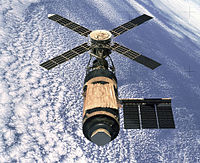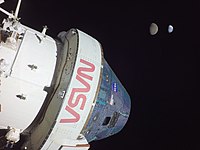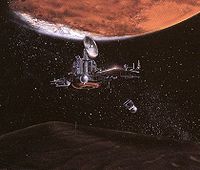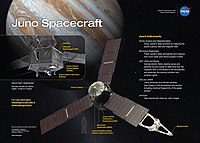| Name |
Mass |
Description |
Orbit |
State |
In service from
|
| International Space Station |
419,725 kg (925,335 lb) |
Space station |
LEO |
In service |
1998– (at present size: 2021)
|
| Mir |
129,700 kg (285,940 lb) |
Soviet / Russian space station |
LEO |
Deorbited 2001 |
1986–2001
|
| Space Shuttle orbiter |
122,683 kg (270,470 lb) |
Space Shuttle Atlantis on STS-117, the heaviest flight of the Space Shuttle. |
LEO |
Retired |
1981–2011
|
| Buran |
105,000 kg (231,485 lb) |
Soviet reusable orbiter of the Buran programme on flight 1K1. [3] |
LEO |
Retired |
1988
|
| Tiangong |
102,000 kg (224,872 lb) |
Chinese space station, with Tianzhou 5 & 6 attached. |
LEO |
In service |
2021–
|
| Starship
|
100,000 kg (220,462 lb)
|
Reusable second stage and spacecraft
|
LEO/GEO/Moon
|
In Flight Testing
|
2023-
|
| Skylab |
77,111 kg (170,001 lb) |
U.S. space station; largest station orbited in one launch |
LEO |
Deorbited 1979 |
1973–1979
|
| Apollo CSM |
28,800 kg (63,493 lb) |
U.S. crewed spacecraft for entering lunar orbit |
Moon |
Retired |
1968–1975 (Block II)
|
| Orion MPCV + European Service Module
|
25,861 kg (57,014 lb)
|
U.S. crewed spacecraft for entering lunar orbit
|
Moon
|
In service
|
2022-
|
| ATV |
20,293 kg (44,738 lb) |
European cargo spacecraft on its heaviest flight |
LEO |
Retired |
2008–2014
|
| Salyut 7 |
19,824 kg (43,704 lb) |
USSR space station |
LEO |
Deorbited 1991 |
1982–1991
|
| KH-11 |
19,600 kg (43,211 lb)[4] |
Electro-optical reconnaissance satellite |
SSO |
In service |
1976– (current version: 2005–)
|
| Salyut 1 |
18,425 kg (40,620 lb) |
USSR space station |
LEO |
Deorbited 1971 |
1971–1971
|
| TKS |
17,510 kg (38,603 lb) |
Soviet crewed spacecraft |
LEO |
Retired |
1977–1985
|
| Proton satellite |
17,000 kg (37,479 lb) |
Space research satellite |
LEO |
Deorbited 1969 |
1965–1969
|
| Apollo Lunar Module |
16,400 kg (36,156 lb) |
U.S. crewed lunar lander |
Moon |
Retired |
1968–1972
|
| Compton Gamma Ray Observatory |
16,329 kg (35,999 lb) |
Space observatory[5] |
LEO |
Deorbited 2000 |
1991–2000
|
| Lacrosse |
14,500 kg (31,967 lb)-
16,000 kg (35,274 lb) |
Radar imaging reconnaissance satellite[6] |
SSO |
Retired
Lacrosse 5 still in orbit |
1988–2005
|
| Hubble Space Telescope |
11,110 kg (24,493 lb) |
Space observatory[7] |
LEO |
In service |
1990–
|
| Jupiter-3 (EchoStar-24) |
9,200 kg (20,283 lb) |
Communications satellite |
GEO |
In service |
2023–
|
| Tiangong-2 |
8,600 kg (18,960 lb) |
Chinese space station |
LEO |
Deorbited 2019 |
2016–2019
|
| Tiangong-1 |
8,506 kg (18,753 lb) |
Chinese space station |
LEO |
Deorbited 2018 |
2011–2016
|
| Envisat |
8,211 kg (18,102 lb) |
Earth observing satellite[8][9] Kessler syndrome threat[10] |
LEO |
In orbit, inoperable |
2002–2012
|
| Chang'e 5 |
8,200 kg (18,078 lb) |
Lunar sample return |
Moon |
In service |
2020–
|
| Shijian-20 |
8,000 kg (17,637 lb) |
Communication Technology Test Satellite[11] |
GEO |
In service |
2019–
|
| Soyuz |
7,080 kg (15,609 lb) |
Russian crewed spacecraft (latest revision used for mass) |
LEO |
In service |
1967– (current version: 2016–)
|
| Telstar 19V |
7,075 kg (15,598 lb) |
Communications satellite |
GEO |
In service |
2018–
|
| TerreStar-1 |
6,910 kg (15,234 lb) |
Communications satellite |
GEO |
In service |
2009–
|
| EchoStar XXI |
6,871 kg (15,148 lb) |
Communications satellite[12] |
GEO |
In service |
2017–
|
| UARS |
6,540 kg (14,418 lb) |
Earth science[13] |
LEO |
Deorbited 2011 |
1991–2005
|
| James Webb Space Telescope |
6,500 kg (14,330 lb) |
Space observatory |
Sun-Earth L2
|
In service |
2021–
|
| Phobos 1 |
6,220 kg (13,713 lb) |
Soviet Mars Spacecraft that missed its orbital insertion burn |
Solar Orbit |
Lost contact 1988 |
1988
|
| Jupiter Icy Moons Explorer |
5,963 kg (13,146 lb) |
Jupiter science probe and Ganymede orbiter |
Jupiter and Ganymede
|
In service |
2023–
|
| Falcon Heavy test flight |
5,900 kg (13,007 lb) |
Maiden flight of Falcon Heavy with Elon Musk's Tesla Roadster, COSPAR 2018-017A |
Solar Orbit |
Lost contact 2018 |
2018
|
| Chandra X-ray Obs. |
5,865 kg (12,930 lb) |
Space observatory[14] |
HEO |
In service |
1999–
|
| GSAT-11 |
5,854 kg (12,906 lb) |
Heaviest Indian communications satellite[15] |
GEO |
In service
|
2018–
|
| Cassini-Huygens |
5,655 kg (12,467 lb) |
Saturn orbiter and Titan probe [16] |
Saturn |
Deorbited 2017 |
1997–2017
|
| Venera 15 & 16 |
5,300 kg (11,684 lb) |
Venus orbiter |
Venus |
Retired |
1983–1985
|
| Venera 10 |
5,033 kg (11,096 lb) |
Venus orbiter & lander |
Venus |
Last contact 1976 |
1975–1976
|
| Tianwen-1 |
5,000 kg (11,023 lb) |
Tianwen-1 Mars orbiter, deployable and remote cameras, lander and Zhurong rover |
Mars |
In service |
2021–
|
| Terra |
4,864 kg (10,723 lb) |
Earth observing satellite |
SSO |
In service |
1999–
|
| Mars 2 |
4,650 kg (10,251 lb) |
Soviet Mars orbiter and lander |
Mars |
Retired |
1971-1972
|
| ExoMars Trace Gas Orbiter |
4,332 kg (9,550 lb) |
Mars orbiter (including Schiaparelli EDM lander)[17] |
Mars |
In service |
2016–
|
| GSAT-24
|
4,181 kg (9,218 lb)
|
Indian Communication Satellite
|
GEO
|
In service
|
2022-
|
| Chandryaan-3
|
3900 kg (8,598 lb)
|
Lunar Lander-rover
|
Moon
|
In service
|
2023-
|
| GPS IIIA |
3,880 kg (8,554 lb) |
Current GPS satellite series |
MEO |
In service |
2018–
|
| Chandrayaan-2
|
3,850 kg (8,487 lb)
|
Lunar Orbiter-Lander-Rover
|
Moon
|
In service
|
2019-
|
| Spektr-R (RadioAstron) |
3,660 kg (8,069 lb) |
Space observatory[18] |
HEO |
In service |
2011–
|
| Juno |
3,625 kg (7,992 lb) |
Jupiter orbiter[19] |
Jupiter |
In service |
2011–
|
| Viking 1 |
3,530 kg (7,782 lb) |
USA Mars orbiter and lander |
Mars |
Retired |
1975-1982
|
| Magellan (spacecraft) |
3,449 kg (7,604 lb) |
Venus orbiter from USA |
Venus |
Deorbited 1994 |
1989–1994
|
| Herschel |
3,400 kg (7,496 lb) |
Space observatory |
Sun-Earth L2 |
Retired |
2009–2013
|
| Galileo |
2,562 kg (5,648 lb) |
Jupiter orbiter and probe[20] |
Jupiter |
Deorbited 2003 |
1989–2003
|
| MAVEN |
2,454 kg (5,410 lb) |
Mars orbiter[21] |
Mars |
In service |
2013–
|
| Lunar Reconnaissance Orbiter |
1,846 kg (4,070 lb) |
Lunar orbiter[22] |
Moon |
In service |
2009–
|
| Lucy (spacecraft) |
1,550 kg (3,417 lb) |
Asteroid space probe launched by USA |
Solar Orbit |
In service |
2021–
|
| Astrosat |
1,513 kg (3,336 lb)
|
Space observatory from India |
LEO |
In service |
2015–
|
| Mars Orbiter Mission |
1,337.2 kg (2,948 lb)
|
India's first Mars mission |
Mars |
Retired |
2013–2022
|
| Venus Express |
1,270 kg (2,800 lb) |
Venus orbiter from ESA |
Venus |
Deorbited 2015 |
2005–2014
|
| MESSENGER |
1,093 kg (2,410 lb) |
Mercury orbiter[23] |
Mercury |
Deorbited 2015 |
2011–2015
|
| Voyager 1 / Voyager 2 |
815 kg (1,797 lb) |
Outer planets / interstellar space[24] |
Solar Escape |
In service |
1977–
|
| New Horizons |
465 kg (1,025 lb) |
Pluto/Kuiper belt probe[25] |
Solar Escape |
In service |
2006–
|
| Malligyong-1 |
300 kg (661 lb) |
Heaviest North Korean reconnaissance satellite, 21 Nov 2023 launch[26][27] |
SSO |
In service |
2023–
|
| Capstone |
25 kg (55 lb) |
Lunar Orbiter |
Moon |
In service |
2022–
|
| MarCO |
13.5 kg (30 lb) each |
Mars Flyby |
Mars |
Lost contact 2019 |
2018–2019
|


















